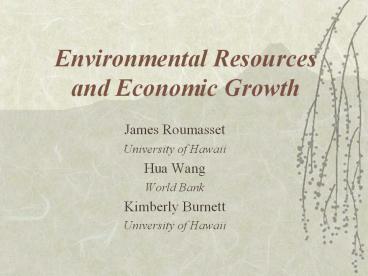Environmental Resources and Economic Growth - PowerPoint PPT Presentation
1 / 28
Title:
Environmental Resources and Economic Growth
Description:
Tianjin, SO2. Taiyuan, TSP. Anshan, TSP. Guangzhou, NOx. Changchun, NOx. Anshan, SO2. Chengdu, TSP ... Falling levels of NOx, SO2, TSP in 11 major cities ... – PowerPoint PPT presentation
Number of Views:166
Avg rating:3.0/5.0
Title: Environmental Resources and Economic Growth
1
Environmental Resources and Economic Growth
- James Roumasset
- University of Hawaii
- Hua Wang
- World Bank
- Kimberly Burnett
- University of Hawaii
2
Environmental Kuznets Curve
Kg SO2 for 55 developed and developing countries,
1987-88, turning point 3137
3
Ambient concentrations in 11 Chinese cities,
1981-2001
NOx
SO2
TSP
4
Major City EKCs
Taiyuan, TSP
Beijing, NOx
Shanghai, SO2
Tianjin, SO2
Anshan, TSP
Guangzhou, NOx
Chengdu, TSP
Changchun, NOx
Anshan, SO2
5
(No Transcript)
6
Why is there no clear pattern?
- Regulation comes in waves
- Growth uneven
- Decentralization
- Relative prices, e.g., coal
- Short time horizon
7
Statistical reporting
- Falling levels of NOx, SO2, TSP in 11 major
cities - Contrasts starkly with bleak qualitative reports
- What information is needed to complete story?
8
Towards improved statistical reporting
- TSP measurement PM 40 vs PM 10
- NOx measurement NO vs NO2
- Decentralization of industry?
- All emissions are not equal need
source-receptor modeling
9
Towards improved statistical reporting cont
- Sampling protocols location, seasonal, weather
factors (Beijing TSP falling, but May 2000,
then Premier Zhu Rongji warned that the rapidly
advancing desert would necessitate moving the
capital from Beijing - Season matters In Beijing, winter SO2 2.7 times
worse for health than average SO2, and 14.2 times
worse than summer SO2 (Brajer and Mead 2004)
10
But with more careful analysis
- Auffhammer et al. (2004) CO2 in 30 provinces
from 1985-2000 - Correct approach is effect of income with
controls on composition of industry, population,
and proximity to the coast - China on the flat part of EKC
- Income not as important for CO2 concentrations as
population growth
11
Water pollution
12
Concentrations
- Proportion in poor water classes decreasing, but
concentrations increasing
13
Natural Resources Water
- Water resources not increasing supply (raw
provision of water to consumers, including
transportation loss, from the water resource)
decreasing - 246.826 million people without running water
- Problem especially severe in populous northern
cities, water scarce, pollution severe, low
income households with no running water
14
- people are found boiling black water and
scraping off the scum that accumulates on the top
for drinking and cooking New York Times, Sept.
12, 2004
15
Soil
- Desertification 900 square miles, 5 billion tons
lost/yr. (Brown, 1994) - Since the 1990s, desertification has been major
land resource concern - But, productivity quantity farmland increasing,
140 million hectares in 1993 (Lindert, 1996) - Soil movement not soil loss
- Increased food imports reflect changing
comparative advantage. - Off-site problems, health effects may be of
greater concern
16
Forests
17
Forests cont
- Total area increasing, total volume rebounding
(Rozelle et al. 2003) but quality, biodiversity
decreasing - Afforestation campaigns fast growing species,
overly dense spacing problems with species
viability, commercial value, biodiversity.
18
Fisheries
Source Chinese Academy of Fishery Sciences
19
Fisheries
- Largest producer in the world, largest number of
fishing boats - Over-fishing, water pollution
- gt decline in stocks
- Regulations in place to limit number of boats but
not quotas - Quotas considered (not ITQs)
20
Energy
21
Coal
22
Energy cont.
- Oil cleaner, less construction time
- Coal consumption still growing especially after
2000 (relative energy cost, import prices) - 2nd largest exporter of coal beginning 2001
23
Depreciation of Natural Capital
- Air pollution growth less than GDP
- Water pollution not greater than GDP
- Renewables decrease in stock reduction
- Non-renewablesextraction growing less than GDP
24
GNNP
- Constant or decreasing wedge
- Opportunities for further convergence, i.e.higher
growth
25
Policy Reform
- Inconsistent regulations across industries and
firm sizes - Weak incentives small fines, no incentives for
inspectors - Lack of enforcement comply only during
inspections, not enough inspectors - Underpricing of natural resources
26
Improvements?
- Water prices going up in some areas
- Experimentation with tradable sulfur permits
27
Remaining Challenges
- More attention to air than water pollution
- Need for water demand management
- Water, forestry resources remain underpriced,
overused - Use of oil has increased, but not as fast as
energy consumption - Major roadblock appears to be public
administration
28
Conclusions
- Substantial progress in energy efficiency and
emissions/BTU - Offset by rapid growth and low per capita income,
i.e. EKC max remains in future - Growth statistics not compromised by failure to
deduct environmental depreciation































